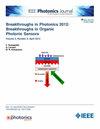Optimized Liveness Detection for Fast and Accurate Fingerprint Anti-Spoofing With Optical Coherence Tomography
IF 2.1
4区 工程技术
Q3 ENGINEERING, ELECTRICAL & ELECTRONIC
引用次数: 0
Abstract
Optical coherence tomography (OCT) offers high-resolution imaging of internal finger structures, making it attractive for fingerprint recognition. Anti-spoofing research in OCT includes both static and liveness anti-spoofing. Liveness anti-spoofing is commonly detected by additional detection equipment or by extracting the liveness information from the OCT data. However, previous methods suffer from long data acquisition and computation times as well as low recognition accuracy. To address these problems, this paper proposes a fast liveness anti-spoofing method. The method requires no additional detection equipment, is fast in data acquisition and calculation, and has high computational accuracy. This study not only explores the method's effectiveness but also performs parameter analysis and optimization on multiple scales. In addition, this paper presents a comprehensive mathematical model that enables various types of OCT devices to calculate the optimal anti-counterfeiting parameters under different conditions. The experimental results show that this method can substantially improve the accuracy and real-time performance of anti-spoofing, and applies to various types of OCT systems, has a promising application in fingerprint identification and other medical diagnostic fields.基于光学相干层析成像的快速准确指纹抗欺骗活性检测
光学相干断层扫描(OCT)提供了高分辨率的手指内部结构成像,使其具有吸引力的指纹识别。OCT的防欺骗研究包括静态防欺骗和动态防欺骗。活体反欺骗通常通过额外的检测设备或通过从OCT数据中提取活体信息来检测。然而,以往的方法存在数据采集时间长、计算时间长、识别精度低等问题。针对这些问题,本文提出了一种快速、活泼的反欺骗方法。该方法不需要额外的检测设备,数据采集和计算速度快,计算精度高。本研究不仅探索了该方法的有效性,而且在多个尺度上进行了参数分析和优化。此外,本文还提出了一个综合的数学模型,使各种类型的OCT器件能够在不同条件下计算出最优的防伪参数。实验结果表明,该方法可以大幅提高抗欺骗的准确性和实时性,适用于各类OCT系统,在指纹识别等医学诊断领域具有广阔的应用前景。
本文章由计算机程序翻译,如有差异,请以英文原文为准。
求助全文
约1分钟内获得全文
求助全文
来源期刊

IEEE Photonics Journal
ENGINEERING, ELECTRICAL & ELECTRONIC-OPTICS
CiteScore
4.50
自引率
8.30%
发文量
489
审稿时长
1.4 months
期刊介绍:
Breakthroughs in the generation of light and in its control and utilization have given rise to the field of Photonics, a rapidly expanding area of science and technology with major technological and economic impact. Photonics integrates quantum electronics and optics to accelerate progress in the generation of novel photon sources and in their utilization in emerging applications at the micro and nano scales spanning from the far-infrared/THz to the x-ray region of the electromagnetic spectrum. IEEE Photonics Journal is an online-only journal dedicated to the rapid disclosure of top-quality peer-reviewed research at the forefront of all areas of photonics. Contributions addressing issues ranging from fundamental understanding to emerging technologies and applications are within the scope of the Journal. The Journal includes topics in: Photon sources from far infrared to X-rays, Photonics materials and engineered photonic structures, Integrated optics and optoelectronic, Ultrafast, attosecond, high field and short wavelength photonics, Biophotonics, including DNA photonics, Nanophotonics, Magnetophotonics, Fundamentals of light propagation and interaction; nonlinear effects, Optical data storage, Fiber optics and optical communications devices, systems, and technologies, Micro Opto Electro Mechanical Systems (MOEMS), Microwave photonics, Optical Sensors.
 求助内容:
求助内容: 应助结果提醒方式:
应助结果提醒方式:


